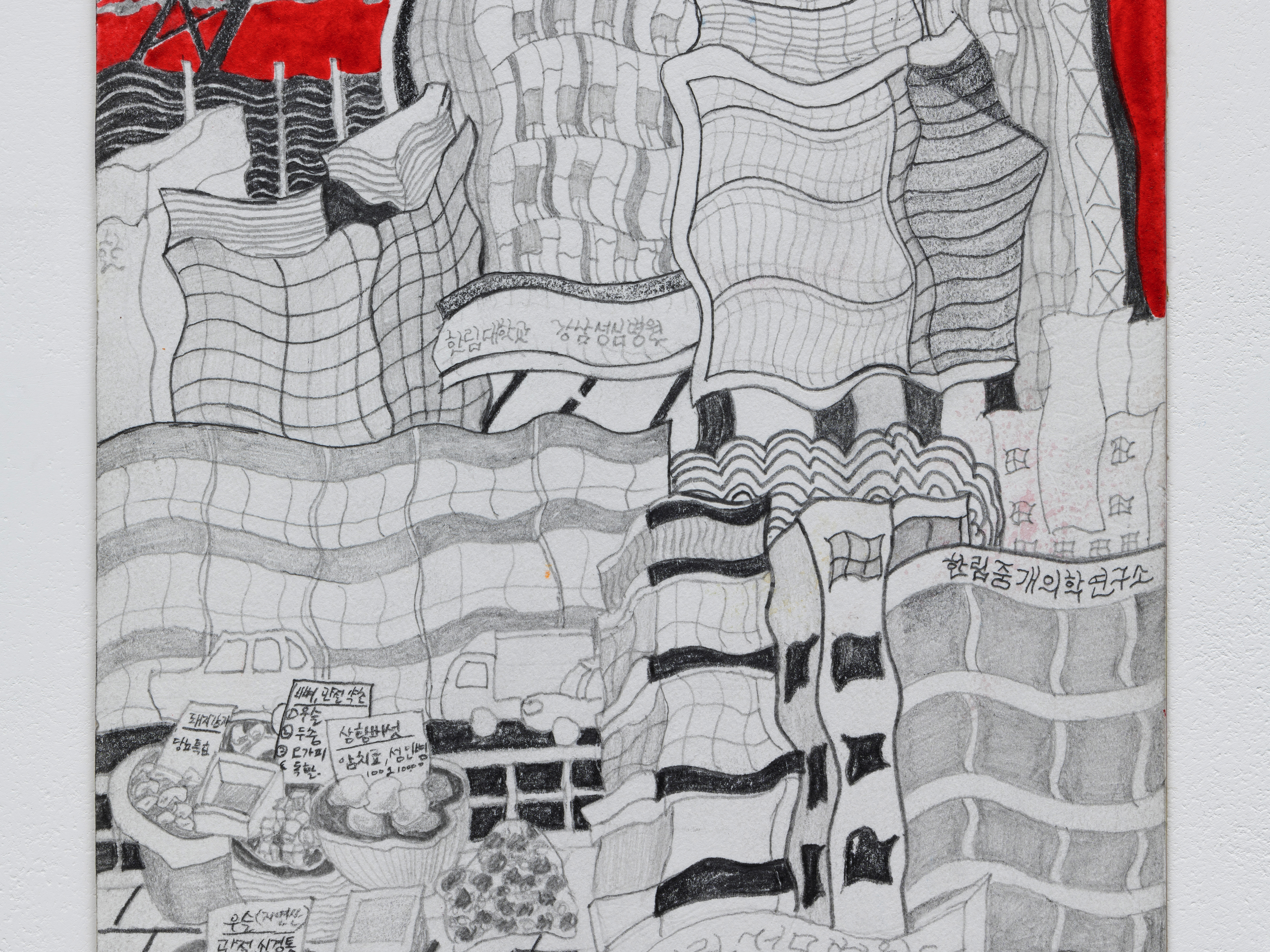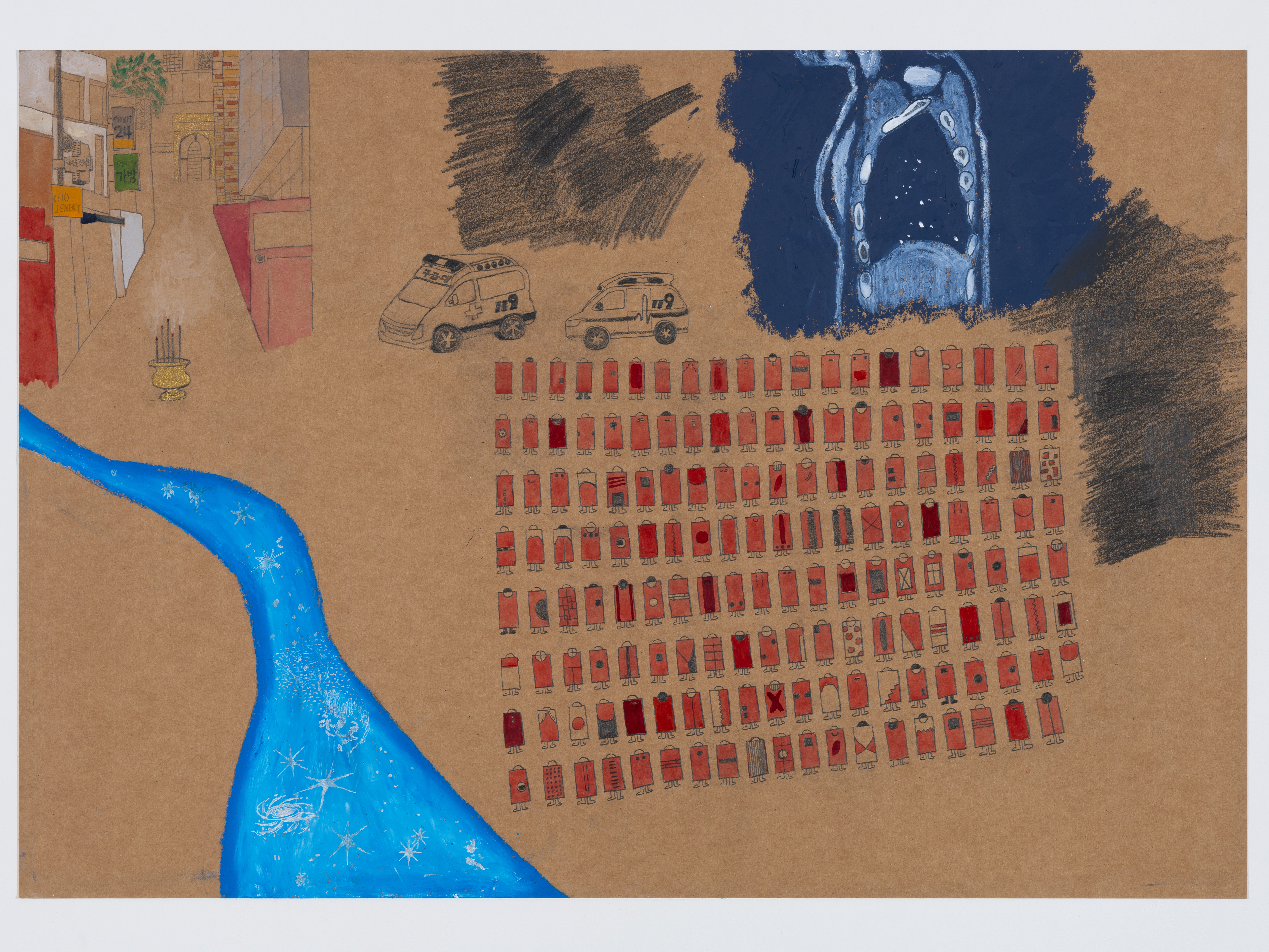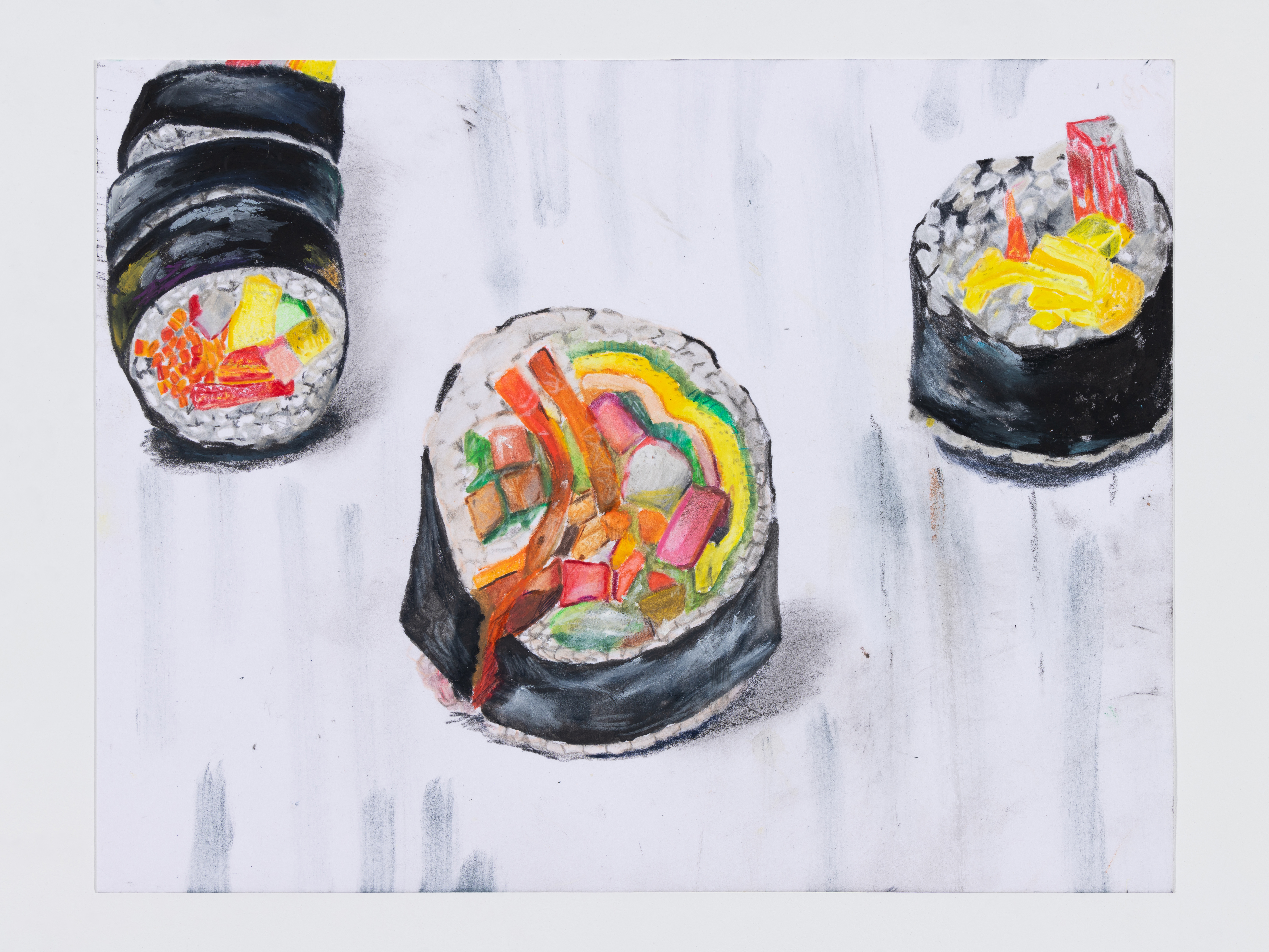Utthita Hasta Padangusthasana on Mount Ann
2019
8.3 * 11.7
pencil on paper
Drawing is one of the activities that heal me. Drawing not only brings joy itself but also provides the bliss of immersion. This drawing depicts me taking care of myself. The woman practicing yoga in this picture is, in fact, me. During a particularly challenging time in life, I started engaging in daily hiking and yoga. I also started gradually doing activities I wanted to do but had been postponing. Drawing as a hobby began during this period. Much like the concept of self-discipline advocated by masters like Park Seobo and the monk Beopgwan, my own drawing practices are in line with Asian ideas of self-care through the arts.
I show myself trying to do a particular yoga pose which I found difficult. As I was drawing, I imagined myself being able to achieve this position one day.
Mount Ann and I
2019
16.5 * 11.2
pencil on paper
In this picture, I tried to capture as many diverse aspects as possible of the numerous trees I have witnessed throughout the seasons. One of my drawing strategies is selectively incorporating diverse and individual objects and living things from the real world into my work. By doing so, I celebrate the beauty of the world, and I acknowledge that these entities contain their own truth, knowledge, and perspective. Although they are partial and small, collecting and analyzing them affords us a richer and more accurate view of society. In this way, we can go beyond conventional perception and revise existing theories, arriving at “new truths”. This approach aligns with feminist and anthropological methodologies, and more broadly, it is a methodology of creation. Like those different trees, such entities as individual women (“International Women’s Day”), various types of trash (“Sleepy Seoul in Autumn”) and animals (“Sharing Water”), are also imagined, selected, and portrayed in order to reveal the real.
Virabhadrasana on the Earth
2019
pencil on paper
The History of Violence
2023
28.9 * 20.3
pencil on paper
This painting is the first one I created after deciding in 2023 to study and pursue art full-time. It criticizes modern capitalism and "the development projects"(McMichael, 1996). In order to transition to a new value system, we must first reflect on and critique the old.
The location depicted in this painting is Gwanghwamun in Seoul, a place politically and economically significant in Seoul and South Korea, akin to Washington D.C. in the United States.
There are many key institutions and buildings in this part of the city, and I chose to draw specific buildings; gate of the Chosun Dynasty (which existed before the establishment of the Republic of Korea), Korean government offices, the National Museum of Korean Contemporary History, the U.S. Embassy, the head offices of the conservative newspapers Chosun Ilbo and Donga Ilbo and so on. I also selected economically symbolic buildings, such as the highest-rent K-Twin Tower and D Tower, Korea Telecom (KT), and Starbucks.
In this street stands a statue of General Lee Sunsin, a revered figure in Korea. He fought in the war when Japan invaded during the ChoSun era. Since childhood, I have wondered why people honor generals who killed people. Statues of generals are not only found in Korea but also in other countries on important streets. While honoring those who defend their community against invasion is justifiable, it seems to accept the premise of conflict and war. Why do humans attack other humans? Why plunder other communities? Why engage in wars that lead to the killing of others? This painting is my response to these longstanding questions.
In conclusion, beneath the facade of modern capitalist systems lies a history of accumulating wealth through invasion and plunder. This is exemplified by the history of the United States and South Korea. The U.S. has politically dominated and economically exploited South Korea over the years, as evidenced by such incidents as the Jeju Uprising (in which the US military killed many innocent Korean citizens), and 1997 Currency Crisis (there is a strong suspicion that the U.S. deliberately exacerbated the Korean currency crisis to facilitate the opening up of the Korean capital market). South Korea is not only a victim in such relationships, but can also be a perpetrator, as seen by its involvement in the Vietnam war, which brought both political and economic benefits. Although General Lee Sunsin defended the Chosun Dynasty against external aggression, the reason his statue was unveiled in the 1960s by then president Park Chunghee was to promote nationalism and mobilize Korean citizens for the purposes of economic development. Park also decided to participate in the Vietnam War on the U.S side, which he believed would help him to maintain his authoritarian dictatorship. McMichael conceptualized the politico-economic entanglements between the First World and the Third World after World War II as "the development projects.”
Such "violent" relationships persist not only between nations but also between the dominating and dominated classes within a nation, and even in everyday urban spaces since the 2000s. While Korea experienced economic growth through the IT industry, the technology giant Samsung, producing semiconductors in overseas factories in Vietnam, Malaysia, India and Brazil amongst others, gained notoriety for labor exploitation, low wages and poor working conditions. Visitors flock to the various shops situated on the lower levels of D Tower, one of Seoul’s most famous landmarks. However, its upper floors house the offices of top law firms, accessible only by exclusive elevators reserved for the privileged few. These tall buildings are a new form of real estate that supposedly signifies progress, yet they block the view of ordinary citizens from below, while wealthy people monopolize the right to gaze out across the city from on high. To enjoy those panoramic views, a person must be in a position to appoint an expensive lawyer. In Korea, where coffee shops are among the main urban relaxation spaces, Starbucks dominates the industry, while taking advantage of lax local labor laws to exploit Korean workers, and using child labor on coffee farms in Central and South America.
Such "violent" relationships persist not only between nations but also between the dominating and dominated classes within a nation, and even in everyday urban spaces since the 2000s. While Korea experienced economic growth through the IT industry, the technology giant Samsung, producing semiconductors in overseas factories in Vietnam, Malaysia, India and Brazil amongst others, gained notoriety for labor exploitation, low wages and poor working conditions. Visitors flock to the various shops situated on the lower levels of D Tower, one of Seoul’s most famous landmarks. However, its upper floors house the offices of top law firms, accessible only by exclusive elevators reserved for the privileged few. These tall buildings are a new form of real estate that supposedly signifies progress, yet they block the view of ordinary citizens from below, while wealthy people monopolize the right to gaze out across the city from on high. To enjoy those panoramic views, a person must be in a position to appoint an expensive lawyer. In Korea, where coffee shops are among the main urban relaxation spaces, Starbucks dominates the industry, while taking advantage of lax local labor laws to exploit Korean workers, and using child labor on coffee farms in Central and South America.
Is it necessary to exploit others and plunder other communities to gain profits? What is the true nature of economic surplus, growthism, and competition? Does an economy whose only purpose is to generate wealth make humanity happy?
In this piece, I drew the universe and galaxies to convey the idea that economic surplus, growthism, and competition – all serving as driving forces in the present system - are truly insignificant from a cosmic perspective. Our current system exploits others, plunders different communities, and destroys the environment for something that is essentially meaningless. In this system, we commit acts of violence to satisfy desires that are as trivial as dust.
In the painting, I replaced the statue of General Lee Sunsin with a humorous depiction of myself practicing yoga. In my drawings, yoga symbolizes self-care and self-nurturing. Through this representation, I aimed to mock the contemporary modern capitalist system while suggesting that taking care of oneself and practicing self-compassion is far more valuable than destroying others for trivial desires.
Urdhva Dhanurasana under Yangwha Bridge
2019
16.5 * 11.2
pencil on paper
This painting and the next painting are artworks in which I depict myself practicing yoga next to the two Han River bridges in Seoul, where I live. In Seoul, a typical metropolis of the post-colonial era, there are numerous tall and expensive buildings, with construction projects happening everywhere. Homes and apartments in Seoul are not regarded as places where people cultivate life, but solely as pieces of property. It is very common for people to move after a couple of years when the price of houses goes up. To navigate life in such a city without being economically exploited or losing your sanity, I believe it is necessary to care for yourself by practicing mindfulness.
I portrayed myself practicing yoga without wearing clothes, symbolizing my commitment to living more honestly and freely, untouched by the complexities of a major city or intricate human relationships.
Sirsasana variations under Hangang Railway Bridge
2019
16.5 * 11.2
pencil on paper
The Hangang Railway Bridge depicted here was the first built across the Han River which most of the trains going to other cities from Seoul need to pass. Just next to this, there is Wonhyo Bridge, which is described as the monster's dwelling in "The Host". This movie was directed by Bong Joonho, who received the Academy Award for Best Picture in 2020 for his film "Parasite." In "The Host," the monster is born from toxic chemicals secretly dumped by the U.S. military, and symbolizes the ugliness and contradictions of Korea's modern system. The film is socially critical, presenting characters and events in a comedic and humorous manner. Bong Joonho is also an alumnus of my university's sociology department. I sometimes feel that his humorous and witty approach to expressing social criticism resonates with certain aspects of my own attitude.
When conceptualizing my artwork, I focus on expressing my attitude, intentions, standpoint, and direction. Unlike in the social sciences, where researchers' biases are controlled, art allows me to express my optimistic and comic perspective and attitude toward social issues, which has significant appeal for me.
Boundary
2023
28.4 * 20.9
watercolor on paper
In my paintings, yoga often symbolizes self-care and self-nurturing, but here I have expanded the meaning in order to examine class dynamics in my daily life. In Korea, yoga is typically seen as an appropriate form of exercise for (young) women to manage their physique or for dieting. In this context, it is more common for those with the time and resources for self-care to engage in yoga, while it is rarer for those with limited time and resources to do so.
In the artwork, I show a typical morning in my apartment, illustrating the subtly tense dynamic that exists between me and the woman who comes to clean it. I started to consider the nature of this relationship after reading the work of anthropologist Pei-Chia Lan (2006), who studied the lives of female migrant domestic workers in Taiwan. In her view, physical and psychological boundaries are important to both employer and employee, in order for each to maintain their identity and negotiate their shared power dynamic.
My cleaning woman is a Chinese woman with Korean ethnicity, who used to be a police officer in China, and she has been cleaning my house for a long time. I treat her kindly, pay her more than the average salary and meet her needs as best I can, while striving to maintain an equal relationship between the two of us. However, it is undeniable that there is an invisible boundary between us. In the painting, this boundary is represented by the dining table, where she once placed some Chinese pastries she had purchased as a gift for me. To my shame, I have never eaten those pastries, and they remain in my refrigerator to this day. My fear is that they may not have been hygienically prepared, and I have to acknowledge that this fear stems from a prejudice that food purchased at the Chinese-Korean market is in some way substandard. I keep the pastries because I hope that I will overcome my prejudice and eat them one day. Similar stories attach to the earplugs and the cup. My shame is all the greater because I was the victim of similar prejudices when studying in London.
Furthermore, this particular yoga position was also strategically chosen for the painting to show the hidden power dynamics within our seemingly equal relationship; while I am performing this peaceful, meditative practice, I am simultaneously watching her and monitoring her work.
In addition to exploring class dynamics in this work, I wanted to draw my private space and show how much I love it. For this reason, I painted a lot of things which are precious to me, including my two cats, my degree certificates, my audio system, and the names of books that are important to me.
Love Yourself
2024
20 *30
mixed media
This is a work I created in a methodology class on the theme of “Brave Painting.” In the short time I had been drawing, I’d never used anything other than paper, pen, and paint, so using a variety of materials was very foreign to me and required a brave decision. In this challenge, I was not only learning to work with different materials, but also to choose the right materials for the subject matter. For example, I used broken glass pieces to represent the heart. When we are hurt by someone, we say “You *break* my heart” and imagine that the heart is something that can be broken. And then we have to mend the broken heart in order to move on. This psychological process is represented by stacking broken shards of glass and gluing them together with resin. The representation of the organs (color, design, etc.) is based on Chinese medicine, which theorizes that each organ has not only its own function but also its own color and role in emotional and psychological processes. Finally, I also reflected my wishes for my body. I drew an eagle around my eyes because, unlike our eyes, eagles’ eyes don’t age. I used pink foam for the upper arm because I would like to have strong muscles. I thought a lot about the background and tried many different colors, but I finally painted an image of wood grain over real wood grain, giving a surrealistic feel. Body organs are usually drawn realistically, and from a scientific point of view, but this painting aims to express a personal, humanistic imagining of the organs. The surrealism of the wooden background seemed to fit with this unrealistic (imaginary, dreamlike) representation of the body, and I ultimately chose this expression.
How I Keep My Life Alive in Chicago
2025
20 *30 (approx.)
oil on canvas


